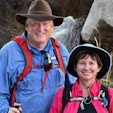Have always been interested in vintage photographs. They capture a historical scene and transmit information about a time and place (Visual literacy). With permission from Peter and Kathy Hafen, I share a photograph from their blogsite: Mt. Pleasant Pioneer Relic Home and Blacksmith Shop.

The photograph from 'Carrie's Photo Album' was taken on July 9th, 1931 and is described as a Lions event (Mt. Pleasant Lions Club outing to Torrey, UT?). In those bygone days, the roads here were gravel - - Hwy 24 from Loa to Torrey was paved in 1941 (Snow; 1953, 76).
James H. Knipmeyer's memoir "Tales from Torrey and of Capitol Reef" briefly tells of the history of The Umpire Store:
"Originally built as a frame building in 1910 and then converted to a rock structure about 1912 or 1913, it was operated as a store by Ephraim P. Pectol. At that time it was known as the Wayne Umpire Store. Why the name 'Umpire,' no one any longer seems to know." (Part III - 1969 Home)
Snow, Anne (1953). Rainbow Views: A History of Wayne County. Art City Publishing Company.





















